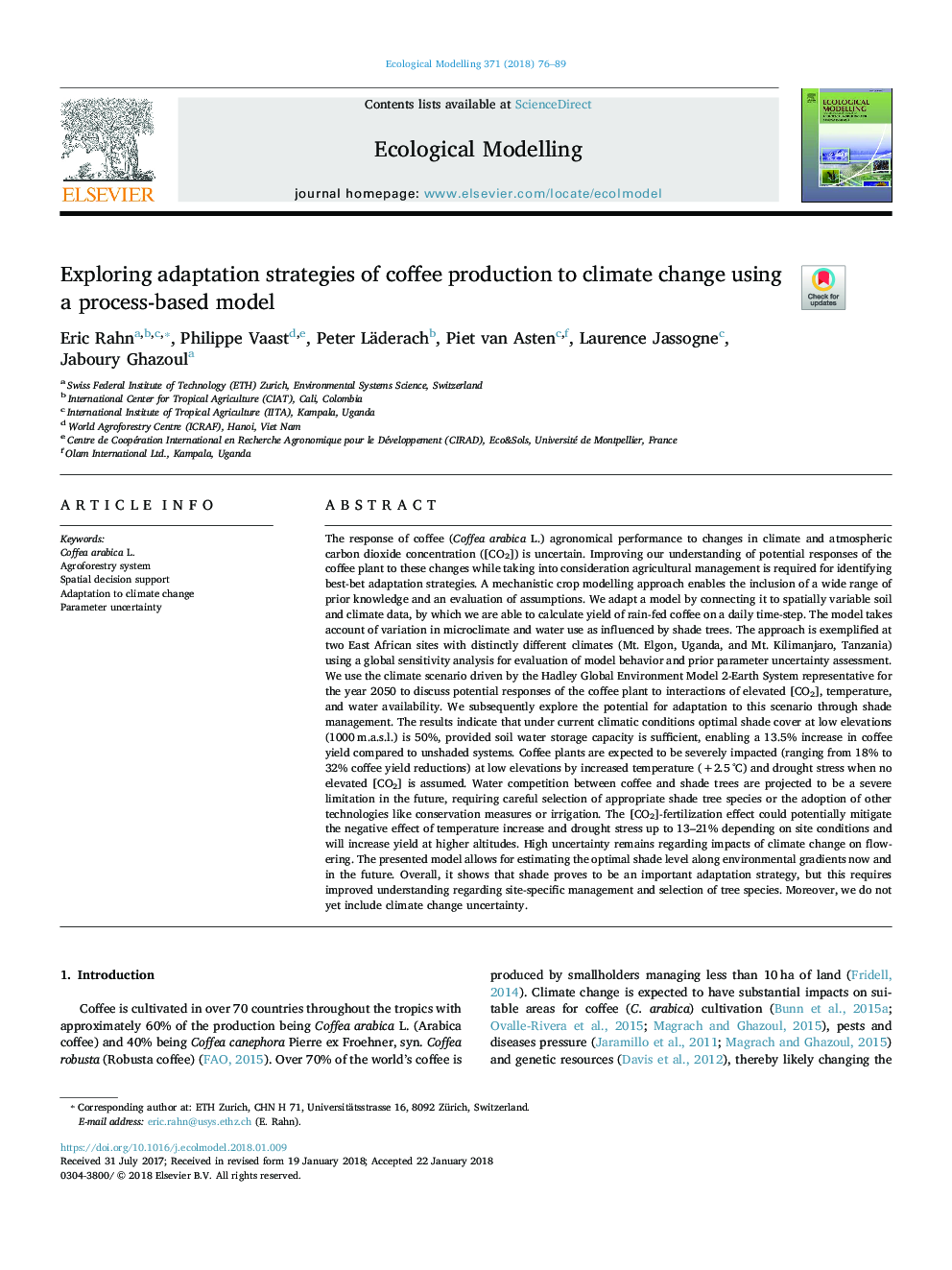| کد مقاله | کد نشریه | سال انتشار | مقاله انگلیسی | نسخه تمام متن |
|---|---|---|---|---|
| 8846104 | 1617376 | 2018 | 14 صفحه PDF | دانلود رایگان |
عنوان انگلیسی مقاله ISI
Exploring adaptation strategies of coffee production to climate change using a process-based model
ترجمه فارسی عنوان
بررسی استراتژی های سازگاری تولید قهوه به تغییرات آب و هوایی با استفاده از یک مدل مبتنی بر فرایند
دانلود مقاله + سفارش ترجمه
دانلود مقاله ISI انگلیسی
رایگان برای ایرانیان
کلمات کلیدی
موضوعات مرتبط
علوم زیستی و بیوفناوری
علوم کشاورزی و بیولوژیک
بوم شناسی، تکامل، رفتار و سامانه شناسی
چکیده انگلیسی
The response of coffee (Coffea arabica L.) agronomical performance to changes in climate and atmospheric carbon dioxide concentration ([CO2]) is uncertain. Improving our understanding of potential responses of the coffee plant to these changes while taking into consideration agricultural management is required for identifying best-bet adaptation strategies. A mechanistic crop modelling approach enables the inclusion of a wide range of prior knowledge and an evaluation of assumptions. We adapt a model by connecting it to spatially variable soil and climate data, by which we are able to calculate yield of rain-fed coffee on a daily time-step. The model takes account of variation in microclimate and water use as influenced by shade trees. The approach is exemplified at two East African sites with distinctly different climates (Mt. Elgon, Uganda, and Mt. Kilimanjaro, Tanzania) using a global sensitivity analysis for evaluation of model behavior and prior parameter uncertainty assessment. We use the climate scenario driven by the Hadley Global Environment Model 2-Earth System representative for the year 2050 to discuss potential responses of the coffee plant to interactions of elevated [CO2], temperature, and water availability. We subsequently explore the potential for adaptation to this scenario through shade management. The results indicate that under current climatic conditions optimal shade cover at low elevations (1000â¯m.a.s.l.) is 50%, provided soil water storage capacity is sufficient, enabling a 13.5% increase in coffee yield compared to unshaded systems. Coffee plants are expected to be severely impacted (ranging from 18% to 32% coffee yield reductions) at low elevations by increased temperature (+2.5â¯Â°C) and drought stress when no elevated [CO2] is assumed. Water competition between coffee and shade trees are projected to be a severe limitation in the future, requiring careful selection of appropriate shade tree species or the adoption of other technologies like conservation measures or irrigation. The [CO2]-fertilization effect could potentially mitigate the negative effect of temperature increase and drought stress up to 13-21% depending on site conditions and will increase yield at higher altitudes. High uncertainty remains regarding impacts of climate change on flowering. The presented model allows for estimating the optimal shade level along environmental gradients now and in the future. Overall, it shows that shade proves to be an important adaptation strategy, but this requires improved understanding regarding site-specific management and selection of tree species. Moreover, we do not yet include climate change uncertainty.
ناشر
Database: Elsevier - ScienceDirect (ساینس دایرکت)
Journal: Ecological Modelling - Volume 371, 10 March 2018, Pages 76-89
Journal: Ecological Modelling - Volume 371, 10 March 2018, Pages 76-89
نویسندگان
Eric Rahn, Philippe Vaast, Peter Läderach, Piet van Asten, Laurence Jassogne, Jaboury Ghazoul,
